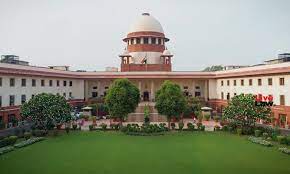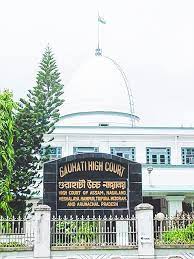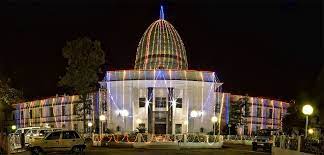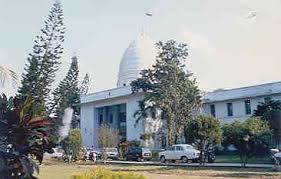Everything was going as per the plan and wish of the main accused Prabhunath Singh, a political leader and a sitting Member of Parliament at the relevant time as he had mustered full support of the Administration and the Investigating Agency; he had influenced and won over almost all the witnesses of fact mentioned in the chargesheet (who were declared hostile), the relevant formal witnesses including the Investigating Officer were not produced in the trial by the prosecution, the Public Prosecutor prosecuting the case was supporting the defence, the Presiding Officers were completely insensitive towards their pious duty, but everything turned upside down when he committed a glaring mistake and that one mistake cost him heavily. He got the court witness, Smt.Lalmuni Devi, mother of deceased Rajendra Rai abducted ten days before the date fixed for recording her statement. (Para 1)
Whereby the said Revision Petition was dismissed confirming the judgment of the Additional Sessions Judge, Fast Track Court- III, Patna dated 24.10.2008 passed in Sessions Trial Nos. 469 of 2007 and 470 of 2007, acquitting Respondent Nos. 2 to 8 of all the charges. (Para 2)
Prabhunath Singh (accused no.1) was avoiding the arrest, nor was he surrendering as he was the member of the ruling party. The District Magistrate, considering the amount of influence being yielded by the accused, found that it was not feasible to conduct the cases in District Saran at Chapra and hence recommended the transfer of all the six cases to Hazaribagh. In all these cases Prabhunath Singh was an accused. The transfer was approved by the High Court. However, later in the year 2000, upon re-organization of the State of Bihar, as Hazaribagh fell in the State of Jharkhand, the present trial was transferred to District Bhagalpur in Bihar. (Para 6)
It was only after 11 years that charges could be framed by the Trial Court on 26.03.2006 against all the accused for offences under various Sections of IPC as stated above. The prosecution examined 11 witnesses. It would be relevant to note that out of these 11 witnesses, PW-1 to PW-7 were examined on a single day i.e. 27.06.2006. The statement of all these seven witnesses were more or less similar to the effect that they saw the incident of firing but did not see who killed the two deceased. All seven witnesses were declared hostile by the Prosecution. PW-8 to PW-10 (three witnesses) were examined on 10.08.2006. (Para 7)
During the trial, on the date of the statement of CW-1 i.e. 03.11.2006, there was some altercation in the Trial Court where the lawyers and pairokar of the accused, assaulted the family members of CW-1 inside the Courtroom. This was reported in the newspapers inviting attention of the Inspecting Judge. The Inspecting Judge set up an inquiry in which he collected evidence and recorded statements. Based upon the same, he gave a detailed report dated 21.02.2007 criticizing the conduct of the Presiding Officer of the Trial Court. (Para 12)
On receiving report of abduction of Lalmuni Devi and Rama Rai, investigation was started and in the night itself Rama Rai appeared before the Officer In- Charge and the Sub Divisional Police Officer. He stated that, apprehending some threats from different quarters, he and his wife had gone underground for self-protection. Rama Rai said that he had come forward on his own to speak the truth about going into hiding on their own accord on account of certain rumors that were spread. Rama Rai, however, refused to disclose the whereabouts of his wife Lalmuni Devi. The Advocate General assured the Court that Lalmuni Devi would be given full protection not only for appearing before the Court but also otherwise so that she may not be harmed by anyone. On the above statement of the Advocate General, the Division Bench of the Patna High Court hearing the Habeas Corpus Petition directed for the production of Rama Rai to record his statement. The next date fixed was 08.11.2006 for production of Rama Rai. It was further provided by the Division Bench that in the meantime if Lalmuni Devi appears before the Trial Court on 03.11.2006, the Court may proceed with the case but if she failed to appear on the said date, the prosecution case should not be closed till further orders by the Court. (Para 13)
On behalf of the writ petitioner before the High Court, it was submitted that their parents were not made free and they were still under the clutches and remote control of the accused. The Division Bench, therefore, did not close the proceedings of the case and adjourned the matter awaiting the result of the enquiry by Justice C.K. Prasad, as he was the Inspecting Judge. (Para 16)
As held in Narmada Devi Gupta (supra), to ensure the reliability of the contents of the FIR/dying declaration, for which along with the inference drawn by us against the subsequent conduct of accusedrespondent no.2 and the aspect of deplorable functioning of the Public Prosecutor, Police Administration and the Presiding Officer of the Trial Court to extend undesirable favour to the accused, the only incriminating evidence is the testimony of Smt Lalmuni Devi (CW-1), which aspect is being dealt with hereinafter. Issue (D) : Testimony of CW-1 (Para 96)
We have noticed that the three main stake holders in a criminal trial, namely the Investigating Officer that is the part of the police of the State of Bihar, the Public Prosecutor, and the Judiciary, have all utterly failed to keep up their respective duties and responsibilities cast upon them. This Court time and again has commented upon the failure of the major stakeholders in the criminal delivery system. (Para 107)
The Trial Court and the High Court miserably failed to notice the sensitivity and intricacies of the case. Both the Courts completely shut their eyes to the manner of the investigation, the Prosecutor’s role, and the highhandedness of the accused as also the conduct of the Presiding Officer of the Trial Court, despite observations and findings having been recorded not only by the Administrative Judge but also by the Division Bench deciding Habeas Corpus petition. They continued with their classical rut of dealing with the evidence in a manner as if it was a normal trial. They failed to notice the conduct of the Public Prosecutor in not even examining the formal witnesses and also that the Public Prosecutor was acting to the advantage of the accused rather than prosecuting the accused with due diligence and honesty. (Para 111)
In the above backdrop of facts and the legal position, the conclusions based on analysis of the evidence in the light of the legal position is as follows:
a) Fard Bayan of Rajendra Rai, which was later converted into an FIR, is admissible in evidence and is to be read as a dying declaration or his last statement.
b) The tainted investigation shows the highhandedness of the accused-Respondent no.2, who was a powerful person, being a sitting M.P. of the Ruling Party
c) The prosecution had established, even through the hostile witnesses, that the date, time, and place of incidence as given in the Fard Bayan of Rajendra Rai were fully established. The only issue was with regard to the identity of the assailants.
d) The post-mortem reports, show that the death of Rajendra Rai and Daroga Rai was homicidal in nature. The medico legal reports supported the prosecution’s story to the extent that the injuries were caused by a fire arm, which proved fatal for two out of the three injured.
e) Adverse inference against the accused is drawn in view of their subsequent conduct.
f) Judicial notice is taken of the judgment in the Habeas Corpus petition dated 13.07.2007 regarding the conduct of the accused, the investigating agency, the Public Prosecutor and the Presiding Officer conducting the trial.
g) The two administrative reports of the respective judges, who were constitutional functionaries, also have to be given due credence and cannot be ignored outright regarding the conduct of the accused, public prosecutor and the Presiding Officer conducting the Trial.
h) The statement of CW-1 is found to be reliable, and the Courts below wrongly discarded it on the ground that it was hearsay and tutored.
i) The dying declaration and the statement of CW-1 fully establish that it was Prabhunath Singh, who had caused the injuries from his firearm weapon, which proved to be fatal for two out of the three injured and also caused injury to the third surviving injured, namely Smt. Devi.
j) Prabhunath Singh (accused no.1) is thus liable to be convicted under Sections 302 and 307 IPC for committing culpable homicide amounting to murder and attempt to murder.
k) The rest of the accused, although named in the chargesheet after due investigation, since their names were not reflected either in the Fard Bayan of the deceased Rajendra Rai (dying declaration) or in the statement of CW- 1, therefore, their acquittal is not disturbed. (Para 114)
Accused-respondent no.2 is thus convicted under Sections 302 and 307 IPC for the murders of Daroga Rai and Rajendra Rai and also for attempt to murder of injured Smt. Devi. (Para 115)
The Secretary, Department of Home, State of Bihar and the Director General of Police, Bihar are directed to ensure that Prabhunath Singh (Respondent No. 2) is taken into custody forthwith and produced before this Court to be heard on the question of sentence in view of Section 235 CrPC. (Para 116)
Let the matter be listed again on 1st September, 2023. On the said date, accused Prabhunath Singh (respondent no. 2) be produced before this Court in custody for the aforesaid purpose. (Para 117)
SUPREME COURT OF INDIA
2023 STPL(Web) 189 SC
[2023 INSC 738]
Harendra Rai Vs. State Of Bihar & Ors.
Criminal Appeal No.1726 of 2015-Decided on 18-8-2023
https://stpllaw.in/wp-content/uploads/2023/08/2023-STPLWeb-189-SC.pdf







